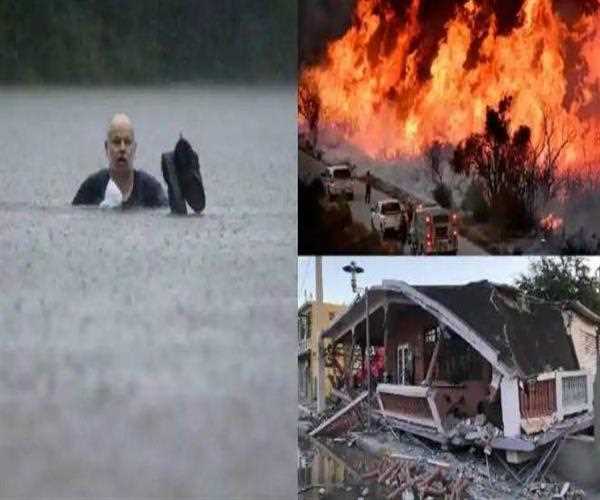Search here

20-Aug-2020
Natural Disasters In 2020 Giving Us Alarm Warning
The cloudburst is responsible for more than sixty deaths in landslides in Pattimudi, located in the Idukki district of Kerala. Similarly, many people are losing their lives due to cloudburst in Pithoragarh in Uttarakhand and Manali district of Himachal Pradesh.
According to the Disaster Control Unit of the Ministry of Home Affairs, 868 people have died in 11 states due to rain and flood in the last two and a half months.
In July, electricity fell from the sky in Bihar and eastern Uttar Pradesh, killing 315 people. Meteorologists consider the fall of lightning and cloudburst to be the inexorable hallmarks of climate change.
Unforeseen conditions such as heavy rains and massive power outages occurred in Bihar and eastern Uttar Pradesh at the beginning of the monsoon due to the unusually hot surface of the earth. The first regional climate change report of the Ministry of Earth Sciences itself has described the rising heat and decreasing events in the weather cycle as a side effect of climate change.
The report warns against the horrific natural dangers surrounding the end of the 21st century for not changing their habits and policies. Despite this, concrete initiatives to improve the environment are not visible at the level of the central or state governments.
Due to the four-day torrential rains in Kerala, the cloud also burst, causing heavy loss of life and property. Not only Munnar and Pettimudi, but the entire rainstorm in the entire Devikulam area from August 2 also came to an end on August 7.
A very unusual total of 184 cm of rain was recorded in Petimudi between August 2 and 7. This is the highest rainfall in an area in Kerala in 96 hours since the 1924 floods.
Similarly, there have been about ten incidents of cloudburst during the monsoon in Uttarakhand and heavy loss of life and property has become common. It is clear that the changing climate cycle from the Himalayas to the coastal areas is increasing the seasonal accident.
READ HERE MORE : USA- India Relations 2020 Are At Stake
Despite becoming a disaster management body in every district, no concrete initiatives are being taken to prevent natural disasters. It is clear from their name that the work of these bodies is not limited to disaster prevention, but is limited to managing the situation arising after its occurrence.
In the capital Delhi, due to the slowing of the monsoon in July, while the northern Arabian Sea continued to heat up unexpectedly, its surface temperature increased by two to three degrees Celsius, normalized by the evaporation of water which is now mixed with the dense monsoon air. Unusual torrential rain.
According to the Meteorological Department, some parts of Jaipur received 25 cm of rain in just six hours this month. From Uttarakhand to Telangana, heavy rains are going on at various places, which are disrupting life and damaging local roads, bridges as well as vehicles and homes.
The Climate Change Assessment Report on the Indian Territory of the Department of Earth Sciences also has a scary picture of similar unexpected tragedies when the temperature of the earth is increased rapidly by greenhouse gases.
This gas originates on the burning of coal and petroleum products and it has predicted the temperature of the Indian territory to rise from 2.7 ° C to 4.4 ° C by the end of the 21st century. According to the report, the loss of climate change has started reflecting the average temperature of the territory of India rising by 0.7 degrees Celsius in the last 119 years.
If we could curb greenhouse gas emissions and population, by the end of the 21st century, the country's internal temperature would rise by another 2.7 degrees Celsius. Conversely, if we indiscriminately increase greenhouse gas emissions by industrialization, the temperature will rise to 4.4 degrees Celsius, which will cause millions of casualties in natural disasters.
The most worrying conclusion of the report is that the heatwave is expected to increase four times by 2100 in April-June compared to 1976-2005. Due to this, the glaciers in the Himalayan regions are rapidly melting and the sea level around Mumbai rises by more than three cm per decade due to the scarcity of drinking water and sinking of the low lying coastal areas.
The sea level is rising at the rate of five cm per decade off the coast of Bengal, which has submerged many villages in coastal forests like the Sunderbans.
According to the report, surface temperatures in the Indian Ocean, including the Bay of Bengal and the Arabian Sea, increased by one degree Celsius during 1951–2015, higher than the global average. The frequency of hot days and nights is expected to increase by 70 percent. This will increase the consumption of electricity to cool the houses while burning more fuel in thermal power plants to increase the production of electricity will increase pollution and heat in the environment.
There is already a possibility of 1.5 million deaths in India every year due to the rise in temperature and heat in the hill resorts. Natural disasters of 2020 India are giving a warning alarm if we do no respond to it then we should complain everything will be lost and our existence will vanish.

Content Writer
I am a Website Developer. And Write Articles on health, general, SEO, gaming, real estate, movies, songs and other reviews. and i also work on SEO search engine optomization.
Join Our Newsletter
Subscribe to our newsletter to receive emails about new views posts, releases and updates.
Copyright 2010 - 2025 MindStick Software Pvt. Ltd. All Rights Reserved Privacy Policy | Terms & Conditions | Cookie Policy